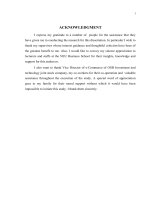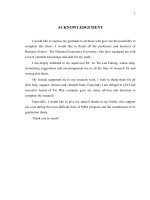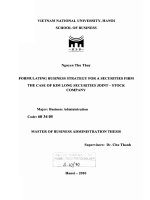key performance indicators for alibaba’s sales staffs at osb investment and technology joint stock company
Bạn đang xem bản rút gọn của tài liệu. Xem và tải ngay bản đầy đủ của tài liệu tại đây (603.18 KB, 77 trang )
ACKNOWLEDGMENT
I express my gratitude to a number of people for the assistance that they
have given me in conducting the research for this dissertation. In particular I wish to
thank my supervisor whose interest guidance and thoughtful criticism have been of
the greatest benefit to me. Also, I would like to convey my sincere appreciation to
lecturers and staffs at the NEU Business School for their insights, knowledge and
support for this endeavor.
I also want to thank Vice Director of e-Commerce of OSB Investment and
technology joint stock company, my co-workers for their co-operation and valuable
assistance throughout the execution of the study. A special word of appreciation
goes to my family for their moral support without which it would have been
impossible to initiate this study. I thank them sincerely.
i
TABLE OF CONTENTS
ACKNOWLEDGMENT i
TABLE OF CONTENTS ii
ABBREVIATIONS v
LIST OF TABLES vi
LIST OF FIGURES AND CHARTS vii
EXECUTIVE SUMAMRY viii
CHAPTER 1
INTRODUCTION 1
Rational 1
Research Objectives 3
Research Questions 3
Research methodology 3
1.4.1Research Process 3
1.4.2Data Collection 4
1.4.3Data Analysis 5
Scope of research 5
Thesis structure 5
CHAPTER 2
THEORETICAL FRAMEWORK
ON KEY PERFORMANCE INDICATORS 6
Nature of Key performance indicator 6
2.1.1Definition of Performance Appraisal and KPIs 6
2.1.2Characteristics of KPIs 9
2.1.3Purposes and benefits of KPI 10
2.1.4Steps to implement KPI 11
Balance scorecard as a tool for KPIs development 12
2.2.1Balance scorecard definition 12
ii
2.2.2Balanced scorecard as a tool to develop KPIs 15
2.2.3 Four perspectives of developing KPIs 19
Factors impacting on developing and using KPIs 25
2.3.1 External factors impacting on developing and using KPIs 26
2.3.2Internal factors impacting on developing and using KPIs 26
CHAPTER 3
DEVELOP THE KEY PERFORMANCE INDICATORS
FOR ALIBABA’S SALES STAFF AT OSB 29
Overview of OSB and Alibaba’s department 29
3.1.1Overview of OSB 29
3.1.2Overview of Alibaba’s department 34
Requirements for Alibaba’s sales staff performance measurement 37
3.2.1Alibaba’s sales staffs job requirements 37
3.2.2Requirements for Alibaba’s sales staffs performance measuarement 40
Develop KPIs for Alibaba’s sales staffs base on BSC 42
3.3.1Respondent profile 42
3.3.2 KPIs for Alibaba’s sales staffs according to financial perspective 47
3.3.3KPIs for Alibaba’s sales staffs according to Education and Growth 47
3.3.4KPIs for Alibaba’s sales staffs according to Internal business process 48
3.3.5KPIs for Alibaba’s sales staffs according to customer perspective 49
CHAPTER 4
SOLUTIONS AND RECOMMENDATIONS TO USE
THE KPIs FOR ALIBABA’S SALES STAFF AT OSB 50
Plan and objective of Alibaba’s department 51
Solution to implement KPIs for Alibaba’s sales staffs at OSB JSC 51
Recommendations to implement KPIs 56
4.3.1Recommendation for Leadership 56
4.3.2Recommendation for HRM 57
4.3.3Recommendation for training activities at OSB 58
iii
CONCLUSION 61
REFERENCES 62
APPENDIX 1
SURVEY QUE STIONNAIRES 64
APPENDIX 2
IN-DEPTH INTERVIEW QUESTIONS 68
iv
ABBREVIATIONS
BSC
GGS
HR
Balance score card
Global Gold suppliers
Human resources
KPIs
OSB
PA
SM
SE
Key performance indicators
OSB Investment and Technology Joint Stock Company
Performance appraisals
Sales Manager
Sales executive
TL Team leaders
v
LIST OF TABLES
Table 2.1 Generic Mesuarements of four perspectives 25
Table 3.1: OSB’s financial highlights from 2010-2012 33
Table 3.2: Current Appraisal Form 40
Table 3.3: Employees’ Perception about OSB’s Strategic Development 43
Table 3.4: Employees’ perceptions about the KPI system 44
Table 3.5: Employees’ satisfaction with current job 45
Table 3.6: Employees’ perceptions about career development opportunities 47
Table 3.7: Employees’ perceptions about working relations and cooperation 48
Table 3.8: Suggested indicator groups and indicators for Alibaba’s sales staffs 50
Table 4.1: Instructions for Evaluating Job Results 53
Table 4.2: Sugested KPI for Sales Manager 54
Table 4.3: Sugested KPI for Sales Executive 54
vi
LIST OF FIGURES AND CHARTS
Figure 1.1 Research Process 4
Firgue 2.1. Model of KPI by David Parmenter 7
Figure 2.2 Balance scorecard framework 15
Figure 2.3: Using the BSC as a strategic Management system 17
Figure 2.4: Internal business process 23
Figure 2.5: Four perspective of Balance scorecard 24
Figure 3.1: OSB structure 29
Figure 3.2 Alibaba’s team structure 36
Figure 3.3 Sales process 37
Figure 3.4: Current Performance Appraisal Flow Chart 42
vii
EXECUTIVE SUMAMRY
Key Performance Indicators (KPIs) are increasingly used by the private and
public sectors to measure progress towards organizational goals using a defined set
of quantifiable measures. For the OSB JSC, KPIs are becoming an essential part of
monitoring Alibaba’s sales staffs.
This research provides an analysis and evaluation of KPIs system which
supporting personnel appraisal activities of Alibaba’s sales staffs at OSB JSC. Its
idea was formed when the research monitored and summarized results of personnel
appraisal of Alibaba’s sales staffs at OSB. The main target is to develop a more
effective appraisal system for sales forces by using KPIs base on BSC. This new
system not only helps leadership evaluate performance appraisal base on the
measurement of four perspectives of BSC but also provides leadership a
comprehensive look and specific strategy’s implementation.
Method of research is analysis, comparisons, synthesis to examine both
primary data and secondary data. Base on given KPIs required, the survey was
conducted to assess the current KPIs for Alibaba’s sales staffs at OSB JSC. In this
step, Four business perspectives of BSC model was to identify their current KPIs.
Different types of data sources were used to gather the data that include OSB’s
report, regulations, procedures, job description, magazines, books and Internet
(secondary data), and surveys and interviews (primary data) which covering
different levels of employees of OSB, the survey questionnaires was directly
distributed through OSB internal mailing system to explore deep information on
how to develop KPI for sales department in Ha Noi .
The research objectives are to analyze the job requirements of sales teams
and performance requirements for Alibaba’s sales staffs, to develop KPIs base on
BSC model model to measure the performance of Alibaba’s sales staff at OSB JSC
and to propose solutions and recommendations to use the KPIs for Alibaba’s sales
team at the OSB. The research covered different issues related to effective KPI
viii
system such as the scope, criteria, method of measurement and procedure of
applying KPIs system, the improvements in new KPIs system, and how the
employees perceive the evaluation conducted by their concerned managers.
Base on KPIs required, thesis suggested some solutions and recommendation
to use KPIs for Sales teams and the company's requirements. The report found the
suitable of having KPI system for Alibaba’s sales staffs to improve their activities.
This thesis also suggested some recommendations to use KPIs for Alibaba’s sales
staffs at OSB Company:
Develop KPIs based on Balance Scorecard model.
Training apply KPIs: Raising awareness and widespread KPI for all officers
and employees, training evaluators and designer of KPIs for Alibaba’s sales staffs
at OSB Company…
Solutions to implement KPIs and recommendation for OSB Company to use
new KPIs system for Alibaba’s sales staffs: Recommendation for awareness of
leadership and recommendation for training activites at OSB.
ix
CHAPTER 1
INTRODUCTION
Rational
People say that selling is a numbers game, and all sales organizations keep
track of certain sets of numbers. It is easy to obsess over the obvious numbers like
monthly or quarterly revenue or close rates. If enterprises want to improve the way
their team plays the game and boost the score in the future, they need to be paying
much closer attention to another set of numbers, namely, the Key Performance
Indicators (KPIs) that give them insights into how well each member of their team
is actually playing.
A KPIs is a measure of a business activity used to estimate how a particular
process is actually performing. It is KEY to the success of the business. For
example, is the number of sales contacts per week important to the success of
organization? It is related to PERFORMANCE when it can be clearly measured,
quantified and easily influenced by the members of team. For example, does a
business have a benchmark that tells sales manager that when a salesman makes at
least 5 contacts with Executive level decision makers during a sales cycle the value
of the final deal will go up by 40%? And it is used as an INDICATOR; in other
words, it is something that provides leading information about future results. For
example, one version of the 80/20 rule says that 80% of a salesman’s production is
generated by activity in 20% of their accounts. Given that information, it might be a
good idea to track the number of calls and the amount of time each sales maker
spends with high value contacts in those accounts, and set some specific
expectations there that can be measured. Essentially, KPIs should provide visibility
into current activity that will impact future sales team productivity. Tracking these
indicators in the present will allow you to identify gaps and coach team members,
which will help manager influence the outcome of those monthly, quarterly and
annual productivity numbers that are so important.
1
With the above benefits of KPIs for sales staff, to ensure business activities
effectively and growing, OSB Investment and Technology Joint Stock Company
(OSB JSC) cannot but carry out employee performance appraisal. However, the
nature of current performance appraisal (PA) at OSB JSC is formal and emotional.
Why is staff appraisal formal and emotional? The fundamental cause of this
existence is that Company has not built performance indicators to appraise for
employee especially for Alibaba’s sales staffs. Because of not having a system of
evaluation criteria, employee performance appraisal at OSB JSC is not exact, not
efficient and does not reach expected goal of leadership. From the inexact
evaluation of employee, it has influenced a range of issues related to human
resource management such as rewards, bonus paying, training, promotion The
inexact evaluation of employee results in unfair rewards, bonus paying, training
wrong people; the promotion did not achieve the purpose of staff development and
there are no motivation to push employees to work better. Due to lack of employee
performance appraisal system, leaders tent to egalitarianism and avoid questions
from staffs. With above evaluation, the employees who work ineffectively and
irresponsibly usually sanction actively, by contrast, who work hard and responsibly
often discontent and certainly decrease performance because they are all equal. In
recent years, productivity of whole sales teams was still not stable. It is so far
behind the dream target of year. Although Vietnam is highly appreciated a potential
market.
In order to help sales staff develop their performance and motivate them
working better, OSB should build a clear and effective employee performance
appraisal system. The KPIs not only provide enough information for evaluation
criteria, career planning, training and other personal decision but also can help
manager to conduct performance appraisal well and help employees in identifying
the knowledge and skills required for performing the job efficiently as this would
drive their focus towards performing the right task in the right way.
2
Therefore, I look forward to improving the current key performance
indicators base on knowledge and applying theories and measures that give me in
Bussiness School of National Economy of University. That is the reason why the
author would like to conduct the research named “Key performance indicators for
Alibaba’s sales staffs at OSB Investment and Technology Joint Stock
Company” with the expectation to contribute OSB JSC development.
Research Objectives
In order to solve the above mentioned problems the author focuses on the
following objectives
Analyze job requirements of Alibaba’s sales staff and performance
requirements for Alibaba’s sales staff at OSB JSC;
Develop KPIs based on BSC model to measure the performance of
Alibaba’s sales staff at OSB JSC
Propose solutions and recommendations to use KPIs for Alibaba’s sales
staff at OSB JSC.
Research Questions
The main research questions to be addresses are:
What is the responsibility of Alibaba’s sales staffs?
What are the performance requirements for Alibaba’s sales staffs at OSB JSC?
What are the KPIs for Alibaba’s sales staffs at OSB JSC base on BSC model?
What are solutions and recommendations to use the KPIs for Alibaba’s
sales staff at OSB JSC?
Research methodology
1.4.1 Research Process
This research was carried out through the literature review and the case study
of Alibaba’s sales staff at OSB JSC. The research includes following aspects:
Data gathering.
Data analysis.
Comparing the study outcome with the proposed theoretical framework.
3
Figure 1.1 Research Process
Source: Author's research
1.4.2 Data Collection
Secondary Data: Collected from academic literatures, popular writings in
research papers, published books, journal articles, and from the World Wide Web,
and the internal circulated documents from OSB JSC’s annual report, working
regulations, working procedures, job descriptions, etc. in order to generalize current
situation of KPIs. In addition to that, secondary data was also utilized to clarify the
performance requirements of Alibaba’s sales staff in OSB JSC when transfering
KPIs into practice.
Primary Data: collected by two sources, surveys and in-depth interviews:
Survey: The survey were designed to collect information about employees’
perceptions and satisfaction of the current KPIs and to find out the gaps between the
current KPIs with the required one and the necessary criteria to improve the the
current KPIs more effectively. Survey is conducted with 15 people including 4 team
leaders and 11 Alibaba’s sales people in OSB JSC at Head office in Ha Noi. The
online employee survey was conducted through internal mailing system to
maximize employee participation and to take their own individual feedback.
4
In-depth interview: Implement to Deputy Director and Sales Manager figure
out the performance requirements of Alibaba’s sales staffs at OSB JSC.
Furthermore, answers to interviews from managers helped to collect information
related to their feelings and opinions about the KPIs and brought a picture of
problems that they have to deal with when transfering KPIs into practice.
The way of conduct interview: The interviews were held face to face. The
duration of each interview was an average of 1 hour. The interviews was conducted
in Vietnamese and major contents were translated into English by writers
The interviewee 1: Mr Tran Dinh Toan – Director of E-commerce division
(Alibaba sales staffs)
The interviewee 2: Mr Dao Manh Khoi – Sales Manager of Alibaba’s sales staffs.
1.4.3 Data Analysis
After collecting all the data, analysis will be conducted with the support of
Excel software and other tools. Based on those outcomes, a new KPIs will be
recommended for OSB JSC.
Scope of research
Research Objects: The Key Performance Indicators for Alibaba’s sales staff at
OSB JSC.
Geographical scope: Alibaba Sales Department in Hanoi
Timing: The secondary data could be collected from 2010 to 2012.
The primary data could be collected in 2013
Thesis structure
The thesis is divided into 4 chapters described as follows:
Chapter 1 – Introduction
Chapter 2 – Theoretical framework on Key Performance Indicators
Chapter 3 – Develop the Key Performance Indicators for Alibaba’s
sales staff at OSB JSC
Chapter 4 – Proposed recommendations to use the Key Performance
Indicators for Alibaba’s sales staff at OSB JSC
5
CHAPTER 2
THEORETICAL FRAMEWORK
ON KEY PERFORMANCE INDICATORS
Nature of Key performance indicator
2.1.1 Definition of Performance Appraisal and KPIs
Definition of Performance Appraisal
Bates & Holton (1995) pointed out the meaning of performance as:
“Performance is a multi-dimensional construct, the measurement of which varies
depending on a variety of factors. It is important to determine whether the
measurement objective is to assess performance outcome or behavior".
Bernadin et al (1995) mentioned that: “Performance should be defined as the
outcomes of work because they provide the strongest linkage to the strategic goals
of the organization, customer satisfaction and economic contributions”. However,
as per Armstrong, (1999 P430), the Oxford English dictionary defines performance
as: “The accomplishment, execution, carrying out, working out of anything ordered
or undertaken”. He added a more comprehensive view of performance, which is
“performance means both behaviors and results. Behaviors emanate from the
performer and transform performance from abstraction to action. Not just the
instruments for results, behaviors are also outcomes in their own right – the product
of mental and physical effort applied to tasks and can be judged apart from results”.
Performance Appraisal is a system that the organization uses to evaluate its
employees performance in order to develop their skills and identify growth
opportunities in the organization if the system was used correctly.
Performance Appraisal is a process in where an individual's performance is
scored and feedback is given. A large component in psychology is trying to measure
human behavior. Performance appraisals are often used in the work place to inform
employees on their work progress. Promotions, bonuses and training needs are often
based on the information provided by a performance appraisal.
6
Tick (2006) posted that an Appraisal is: "a formal evaluation of the
performance of an employee over a particular period of time. A good appraisal
should identify the strengths and weaknesses and the improvement opportunities."
Appraisal is supposed to be a planned meeting between the employee and the
concerned manager. It provides opportunity to have an overall view of performance
to discuss what was achieved against the agreed objectives.
Weightman (1999) said that performance appraisal is a well-established way of
providing milestones, feedback, guidance and monitoring for employees. The essential
elements of any performance appraisal are judgment and reporting. The performance
appraisal is not simply being measured as in the completion of workload, it is being
judged. This judgment not only has to be made but also passed on to other people in
such a way that the other understands what it is intended and takes action upon.
Definition of KPIs
KPIs is a method Performance Measurement (job performance) by setting up a
system of performance indicators (with a systematic set of indicators aimed at helping
an organization define and measure progress toward organizational goals). Once an
organization has analyzed its mission, identified all its stakeholders, and defined its
goals, it needs a way to measure progress toward those goals. Key Performance
Indicators are those measurements. Including 100 index, the index is divided into 3
types: KRI (key result indicator), PI (performance index) and KPI (key performance
indicator). By David Parmenter, there are 3 types of performance indicators are:
Firgue 2.1. Model of KPI by David Parmenter
Source: Key Performance Indicator by DAVID PARMENTER
KPI
KRI
PI
7
• Outcome Indicators crucial - KRI: to know you have done with one
perspective (finance, customer, internal processes, Learning &
Development, Environment & Community Satisfaction of staff .) in the
organization's strategy.
• Performance index - PI: What do you need to know.
• Key performance indicators - KPIs: to know you have to do to increase
the performance significantly.
For performance measurement system needs to establish measurable
performance indicators. The focus of the key performance indicators is measuring
the process and the results of the most crucial decisions to the organization's
success. Toward the mission, vision, strategy of the organization, the system is
designed only stratification from level to level the organizations / groups /
individuals, reflecting the results of operations of all levels within the organization.
Originating from requirements of the measurement results in business performance,
KPI approach was introduced in the U.S. in the 80s of the 20th century, then with
the advent of the equilibrium of 2 Cards S.Kaplan author Robert and David Norton,
KPI is widely used around the world as one effective method to measure the
performance through the first set and measure system performance. KPI method has
also been applied in organizations such as the Government of Malaysia. Currently,
the method is carried out KPI is quite strong in Vietnam, especially in the business
has successfully applied ISO 9001.
The key stages in identifying KPIs are:
• Having a pre-defined business process (BP).
• Having requirements for the BPs.
• Having a quantitative/qualitative measurement of the results and
comparison with set goals.
• Investigating variances and tweaking processes or resources to achieve
short-term goals.
8
2.1.2 Characteristics of KPIs
KPI characteristics include the following.
KPIs are non-financial measures: KPIs are not expressed in monetary
figures. When putting a pound sign to a measure it means that has not dug deep
enough. Sales made yesterday will be a result of sales calls made previously to
existing and prospective customers, advertising, and amount of contact with the key
customers, product reliability, etc. Any sales indicators expressed in monetary terms
are result indicators.
In many organizations, a KPI may rest with certain activities undertaken with
key customers, who often generate most, if not all, of profit.
KPIs are measured frequently: KPIs should be monitored and reported
24/7, daily, and a few, perhaps, weekly. A KPI can't be measured monthly as this is
shutting the stable door well after the horse has bolted.
KPIs are current or future measures, as opposed to past measures. Most
organizational measures are past indicators, measuring events of the last month or
quarter. These indicators cannot be and never were KPIs. That is why a satisfaction
percentage (e.g. 65%) from a customer satisfaction survey performed every six
months can never be a KPI.
KPIs are acted upon by the CEO and senior management: All good KPIs
that make a difference should have the CEO's constant attention, with daily calls to
the relevant staff. Having a potentially career-limiting discussion with the CEO is
not something staff wants to repeat.
KPIs are understood by staff: A KPI should make clear what action is
needed. In the case of an airline that was having a problem with late planes, a KPI
communicated immediately to all staff that there needed to be a focus on recovering
the lost time. Cleaners, caterers, ground crew, flight attendants and liaison officers
with traffic controllers would all work some magic to save "a minute here and a
minute there" while maintaining or improving service standards.
9
KPIs are the responsibility of individuals: A KPI is deep enough within an
organization to be tied down to an individual. In other words, the CEO can ring
someone and ask "why?" Return on capital employed has never been a KPI as it
cannot be tied down to a manager; it is a result of many activities under different
managers.
KPIs have a significant effect on the organization: A KPI will affect most
of the critical success factors (CSFs) and more than one balanced scorecard
perspective. In other words, when the CEO focuses on the KPI and the staffs follow
the organization scores goals in all directions.
KPIs have a positive effect on other measures: A KPI has a flow-on effect
on other performance measures. Reducing late planes would improve performance
measures around improved service by ground staff as there is less "firefighting" to
distract them from a quality and caring customer contact.
2.1.3 Purposes and benefits of KPI
KPI will help the sales manager make better decisions. He must have timely
and accurate information about all aspects of the performance of his team members
in order to plan and coach effectively. He can’t rely on hope and assumptions; he
must be assessing real data in real time that will reveal what is going on so he can
take action now, before it is too late.
This leads to better execution. Identifying, measuring and – most of all -
coaching to the right KPIs leads directly to behavior change and skill improvement
across the entire team.
KPIs set expectations and improve communication. Defining KPIs clarifies
for sales makers the activities upon which they should be spending their time, and
provides a context for sales managers to interact with sales makers regarding their
performance.
A clear focus on KPIs will change sales maker behavior. Once sales makers
understand the activities they are supposed to be concentrating on, they will devote
10
more time and energy to these areas, especially if they know their compensation
will be tied to their performance in these areas.
Focusing on a core set of KPIs will keep sales maker activities consistent.
There is an old saying; “People don’t do what is expected, the only do what is
inspected.” When sales makers understand what you are going to inspect every
week, they are much more likely to do them every week.
Tracking KPIs is the best way to identify and qualify sales maker
performance. Sales makers might be staying busy and giving a 100% effort every
day, which can be confused with real productivity. However, if they aren’t giving
that effort to the right activities, all that effort is wasted. Tracking KPIs helps sales
managers make sure sales makers are spending the right amount of time on the right
activities.
Tracking KPIs takes the guess work out of evaluation and coaching. This is
related to the previous point. Sales managers who don’t regularly track sales maker
performance against a set of standard KPI metrics don’t really have any objective
basis for evaluating performance. The sales maker may be a great person and hard
worker, or they may be a disagreeable know-it-all, but those aren’t the most
important behaviors for a sales manager to evaluate. The only thing that really
matters is how they are performing in relation to the KPIs.
Effective coaching begins with KPIs. Most sales managers understand that
coaching is important, but coaching is useless if it is not based on quantifiable,
actionable skills and behaviors. The greatest value of tracking KPIs is the
information they reveal about where each sales maker is doing well, and where they
might need to help to do better. Sales managers can quickly access KPI’s from their
CRM for every sales maker and use this data to customize coaching conversations
that will address gaps and boost performance.
2.1.4 Steps to implement KPI
KPIs give everyone in the organization a clear picture of what is important,
of what they need to make happen. The boss uses that to manage performance.
11
He /She make sure that that everything the people in his organization do is focused
on meeting or exceeding those Key Performance Indicators. There are 5 steps to
implement KPI as follow:
Step1: Implementation BSC to department
Step2: Fulfill Job description based on the BSC and KPI (individual KPI)
Step3: Set up evaluation criteria (Criteria capacity, result performance )
Step4: Organizing the implementation and evaluation
Step5: Report performance result and records
Identify and define essential factors that are critical to achieving your
organization's goals. For example, a sales department may define success by
increased sales success. However, sales alone is too general of a measure. A
KPI accurately defines and measures increased sales. A better measure of
sales success would be the number of units sold or number of sales at list
price.
Denote a quantity that will represent your company's success. This quantity
must be a measurable value, such as percent, number, dollar value, etc.
Post the KPIs in places that will show all stakeholders what the target is for
each KPI. Show the progress toward each target. Post the KPIs in
lunchrooms, conference rooms and company newsletters. KPIs give
employees a picture of what is important to the organization
Balance scorecard as a tool for KPIs development
2.2.1 Balance scorecard definition
The following definitions of the Balanced Scorecard concept present a rich
picture from multiple angles:
"The balanced scorecard retains traditional financial measures. But financial
measures tell the story of past events, an adequate story for industrial age
companies for which investments in long-term capabilities and customer
12
relationships were not critical for success. These financial measures are inadequate,
however, for guiding and evaluating the journey that information age companies
must make to create future value through investment in customers, suppliers,
employees, processes, technology, and innovation.” (Kaplan R.S. and Norton D.P.
(1992) The Balanced Scorecard - Measures that drive performance, Harvard
Business Review, Jan-Feb.)
A tool that translates an organization's mission and strategy into a
comprehensive set of performance measures that provides the framework for a
strategic measurement and management system.” (Balanced Scorecard
Collaborative, 2005, Online)
The balanced scorecard is a strategic planning and management system that is
used extensively in business and industry, government, and nonprofit organizations
worldwide to align business activities to the vision and strategy of the organization,
improve internal and external communications, and monitor organization
performance against strategic goals. (Balanced Scorecard Institute, 2010)
The balanced scorecard has multiple meanings. The initial meaning when it
was first popularized in early 90s was of an approach for generating a performance
report, by grouping performance measures by perspectives, the most commonly
used being: Financial, Customer, Internal Processed and Innovation and Learning.
Gradually, this management tool evolved to become the basis on a performance
management system that usesstrategic, operational and individual performance
plans as the basis for a communicating, monitoring and improving organizational
performance.(eab group, 2010)
The balanced scorecard is a strategic planning and management system that
is used extensively in business and industry, government, and nonprofit
organizations worldwide to align business activities to the vision and strategy of the
organization, improve internal and external communications, and monitor
organization performance against strategic goals. It was originated by Drs. Robert
Kaplan (Harvard Business School) and David Norton as a performance
13
measurement framework that added strategic non-financial performance measures
to traditional financial metrics to give managers and executives a more 'balanced'
view of organizational performance. While the phrase balanced scorecard was
coined in the early 1990s, the roots of the this type of approach are deep, and
include the pioneering work of General Electric on performance measurement
reporting in the 1950’s and the work of French process engineers (who created the
Tableau de Bord – literally, a "dashboard" of performance measures) in the early
part of the 20th century.
The balanced scorecard has evolved from its early use as a simple
performance measurement framework to a full strategic planning and management
system. The “new” balanced scorecard transforms an organization’s strategic plan
from an attractive but passive document into the "marching orders" for the
organization on a daily basis. It provides a framework that not only provides
performance measurements, but helps planners identify what should be done and
measured. It enables executives to truly execute their strategies.
This new approach to strategic management was first detailed in a series of
articles and books by Drs. Kaplan and Norton. Recognizing some of the weaknesses
and vagueness of previous management approaches, the balanced scorecard
approach provides a clear prescription as to what companies should measure in
order to 'balance' the financial perspective. The balanced scorecard is a management
system (not only a measurement system) that enables organizations to clarify their
vision and strategy and translate them into action. It provides feedback around both
the internal business processes and external outcomes in order to continuously
improve strategic performance and results. When fully deployed, the balanced
scorecard transforms strategic planning from an academic exercise into the nerve
center of an enterprise.
Kaplan and Norton describe the innovation of the balanced scorecard as
follows:
14
"The balanced scorecard retains traditional financial measures. But financial
measures tell the story of past events, an adequate story for industrial age
companies for which investments in long-term capabilities and customer
relationships were not critical for success. These financial measures are inadequate,
however, for guiding and evaluating the journey that information age companies
must make to create future value through investment in customers, suppliers,
employees, processes, technology, and innovation."
Figure 2.2 Balance scorecard framework
Sourvce:Kaplan & Norton 1996. The Balance scorecard. Havard Business School press 9.
Original from HBR Jan/ Feb 1996, p.76
2.2.2 Balanced scorecard as a tool to develop KPIs
Management control systems (MCS) are the information systems and the
various applications software‘s that managers use to direct the behaviors and
actions of its members towards the goals of the company. Otley (1994), define
management control as the process by which managers assure that resources are
obtained and used effectively and efficiently to accomplishment the goals of an
15
organization. In another study, Otley (2003), considers the BSC as a novel
management control tool. In fact, the BSC was design to serve as a control tool for
managers originally. In their earlier writings on the BSC, Kaplan and Norton (1992)
define BSC as a set of measures that give top managers a fast view of their
business. These measures were aim to help managers control their organization. To
use BSC as a management control tool involves four processes shown in Figure 2;
namely;
Clarifying and translating the vision and strategy of the organization. This
process enables that, managers agree on the direction the company should follow
and make it known to other employee. This involves setting appropriate targets and
motivating the employee to reach them. The second process, communication and
linking; ensures that the goals of the organization is made known to all the different
units of the organization. The process involves linking the business unit goals to
those of the organization. It also involves coordination of the various departmental
activities such that a common vision is shared among organizational participant.
The third process, planning and target setting, ensures the business plans is in
line with the financial goal. In the planning and target setting process, the how to
achieve organizational goals are elucidated and the measures in the BSC are use as
the basis to allocate the resources. The final process, feedback and Learning; makes
sure adequate feedback is received from the various activities. The feedback process
begins with a clarification of vision for the organization. The whole process form a
loop, whereby the feedback received from the management process are then used
again to reshape corporate strategy and the process goes on and on.
16









